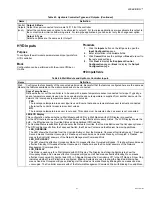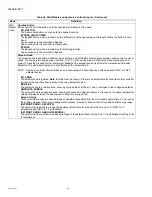
WEBVISION™
81
95-7769—01
UV Outputs Wiring Assignment
Use Table 61 to configure the outputs of a Unit Ventilator to
actual physical outputs on a unit ventilator controller.
Purpose
Modify terminal assignments for configured outputs.
Mode
Configuration can be performed with the wizard Off-line or
On-line.
Limits
Outputs must be configured using the
Unit Ventilator
Controller Outputs
page.
Procedure
1.
Click the
Wiring Assignment
button on the left pane to
open the
Wiring Assignment
page.
2.
Enter information into available fields.
3.
Click
Commit
to save the settings or
Reset
to revert to
the last saved settings.
4.
Click
Next
to display the
Wiring Diagram
page or
Back
to display the
PID Configuration
page.
UV Outputs fields
Cooling
Integral
Time
Integral Time
Determines what impact the error-over-time has
on the output signal. Error-over-time has two
components that make up its value: the amount
of time the error exists and the size of the error.
The higher the integral time, the slower the
control response. In other words, a decrease in
Integral Time causes a more rapid response in
the output signal.
Enter the range in seconds: 0 to 5000.
Cooling
Derivative
Time
Derivative Time or Gain
Determines what impact the error rate has on the
output signal. The error rate is how fast the error
value is changing. It can also be the direction
space temperature is going, either towards or
away from the setpoint and its speed - quickly or
slowly.
A decrease in Derivative Time causes a given
error rate to have a larger effect on the output
signal.
Enter the range in seconds (0 – 9,000).
Heating
Throttling
Range
Throttling Range or Proportional Gain
Determines what impact the error has on the
output signal.
Decreasing the Throttling Range amplifies the
effect on the error, that is, for a given error (the
difference between the measured space
temperature and the current actual space
temperature setpoint), a small Throttling Range
causes a higher output signal value.
Enter the range in degrees: 2 to 30 °F
(-17 to -1 °C)
Heating
Integral
Time
Integral Time
Determines what impact the error-over-time has
on the output signal. Error-over-time has two
components that make up its value: the amount
of time the error exists and the size of the error.
The higher the integral time, the slower the
control response. In other words, a decrease in
Integral Time causes a more rapid response in
the output signal.
Enter the range in seconds: 0 to 5000.
Table 60. Unit Ventilator PID Settings. (Continued)
Name
Definition
Heating
Derivative
Time
Derivative Time or Gain
Determines what impact the error rate has on the
output signal. The error rate is how fast the error
value is changing. It can also be the direction
space temperature is going, either towards or
away from the setpoint and its speed - quickly or
slowly.
A decrease in Derivative Time causes a given
error rate to have a larger effect on the output
signal.
Enter the range in seconds: 0 –to 9000.
Table 61. Unit Ventilator Outputs - Terminal Assignments.
Name
Definition
Default
Assignment
This column displays the default
assignments as the outputs are
configured in the Outputs page
Custom
Assignment
Custom assignment – to change the
assignments
Existing
If the device is online, this shows the
assignments as in the device. Else, it
shows from the database
Table 60. Unit Ventilator PID Settings. (Continued)
Name
Definition
















































